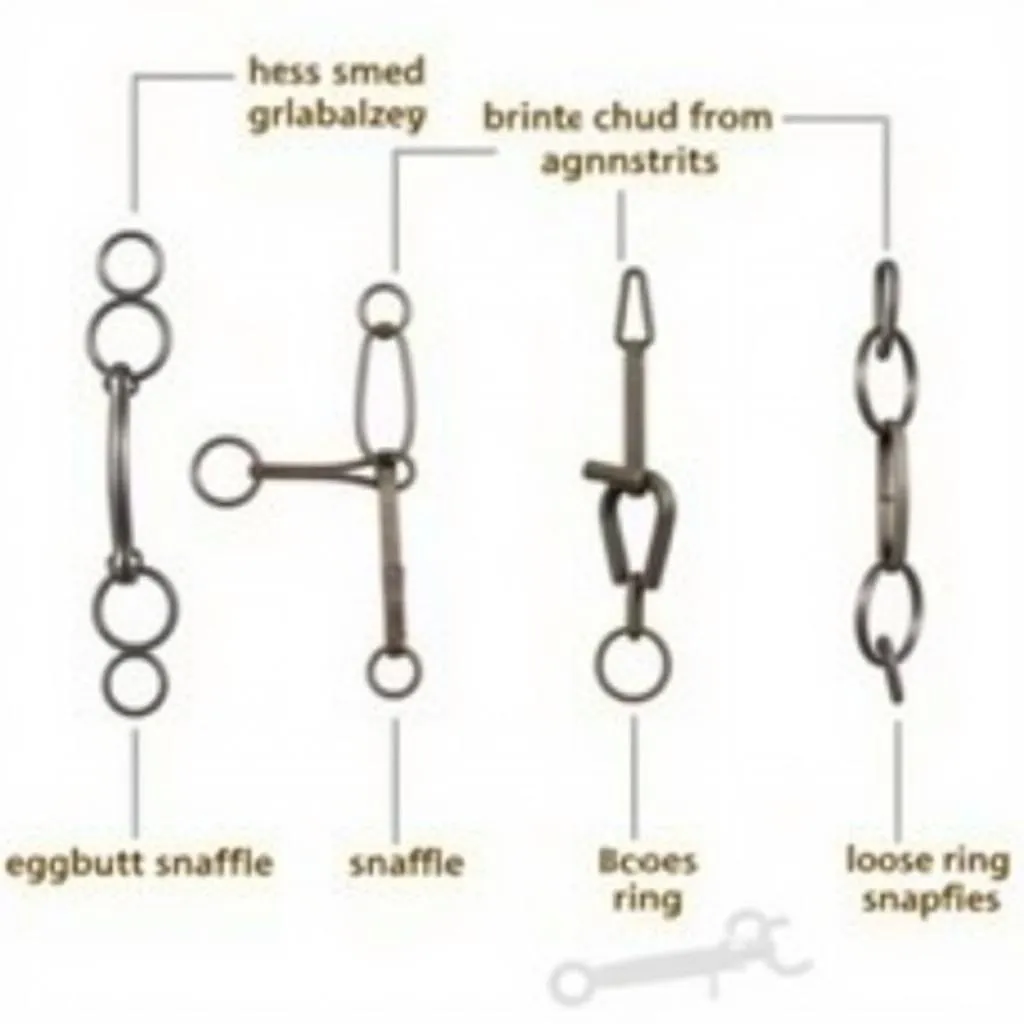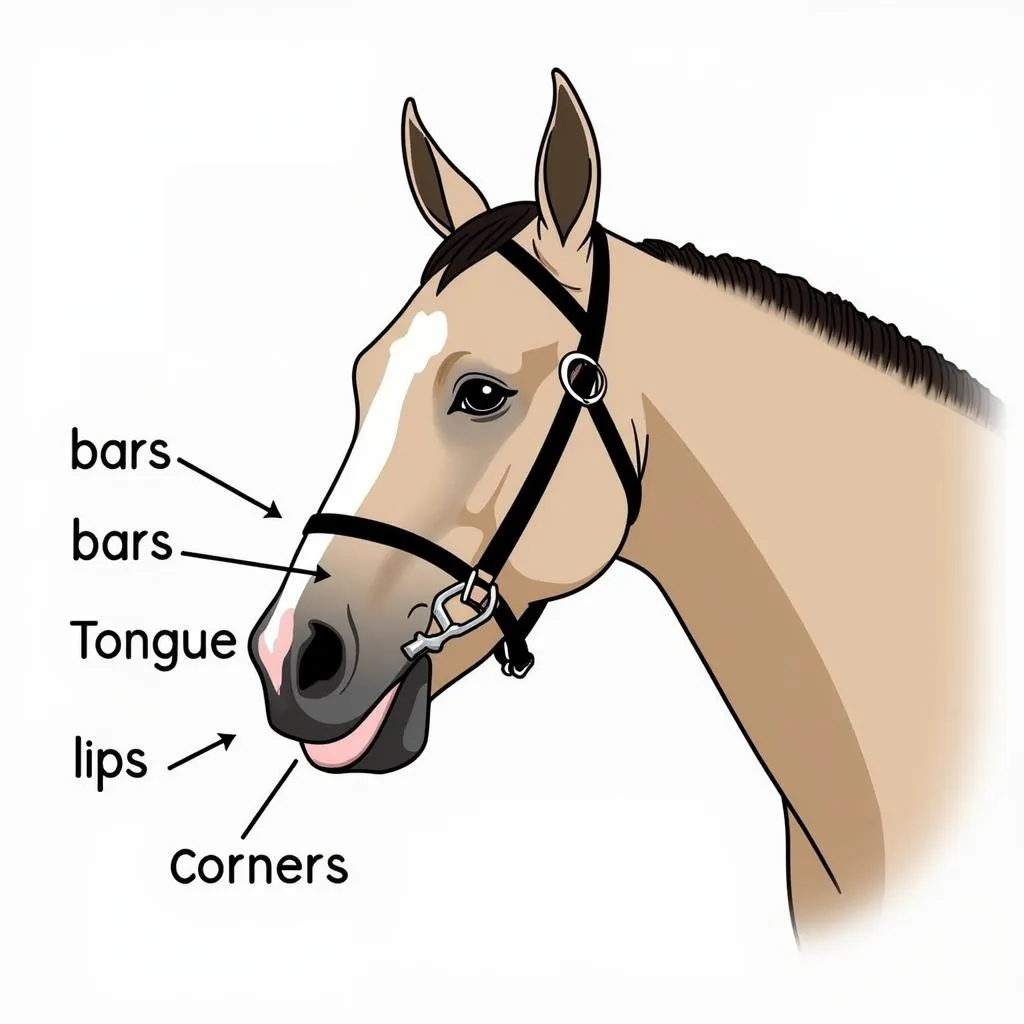Finding the Best Bit For A Young Horse can feel like navigating a maze. With countless options available, it’s easy to get overwhelmed. This guide is here to help you understand the nuances of bits and empower you to make the right choice for your young equine partner.
 Different Types of Bits for Young Horses
Different Types of Bits for Young Horses
Understanding the Basics of Bits
A bit is a crucial communication tool between you and your horse, acting on the bars, tongue, and corners of their mouth to convey directional cues. For young horses just starting their training, the type of bit you choose plays a significant role in their comfort, understanding, and overall development.
The wrong bit can lead to confusion, resistance, and even potential injury. Therefore, prioritizing a bit that promotes a positive learning experience is paramount. This means opting for bits that are gentle, straightforward, and encourage clear communication without causing discomfort.
Key Factors to Consider
When selecting a bit for your young horse, several factors come into play:
- Age and Stage of Training: A horse new to bit pressure requires a gentler option compared to one with several months of groundwork.
- Mouth Conformation: Horses have unique mouth structures. Some have fleshy tongues, while others have sensitive bars.
- Temperament and Sensitivity: A more sensitive horse benefits from a milder bit, while a laid-back individual might be less reactive.
- Riding Discipline: The demands of different disciplines necessitate specific bit choices.
 Anatomy of a Horse's Mouth in Relation to a Bit
Anatomy of a Horse's Mouth in Relation to a Bit
Exploring Bit Types for Young Horses
1. Snaffle Bits: The Foundation
Snaffle bits are the most common starting point for young horses. They are considered “direct pressure” bits, meaning the pressure applied to the reins directly corresponds to the pressure felt on the horse’s mouth.
- Loose Ring Snaffle: The rings on this bit rotate freely, encouraging the horse to relax their jaw and seek the bit.
- Eggbutt Snaffle: Similar to the loose ring, but with fixed egg-shaped attachments to the mouthpiece, offering a slightly steadier feel.
- D-Ring Snaffle: The D-shaped rings provide lateral stability, making it suitable for horses that tend to lean or get strong.
2. Mullen Mouth Bits: Gentle and Stable
Mullen mouth bits feature a solid mouthpiece that lies flat across the tongue, distributing pressure more evenly and minimizing the “nutcracker” effect of jointed snaffles.
- Rubber Mullen Mouth: The rubber coating is gentler on the bars and encourages salivation, making it a good option for sensitive youngsters.
- Happy Mouth Mullen Mouth: These bits are often made from synthetic materials designed to be softer and more palatable.
Common Mistakes to Avoid
- Using a Bit Too Harshly: A harsh bit in inexperienced hands can create fear and resistance. Remember, less is more.
- Ignoring Signs of Discomfort: Head tossing, tongue lolling, and gaping are all signs of discomfort.
- Neglecting Proper Fit: A poorly fitted bit can pinch, rub, and cause pain, hindering your horse’s progress.
Finding the Perfect Fit
Proper bit fit is crucial. A bit that’s too large will slide excessively, while a bit that’s too small can pinch and cause discomfort. Consult with an experienced equine professional, such as a veterinarian or a certified bit fitter, to ensure the best fit for your horse’s unique mouth conformation.
When to Transition to a Different Bit
Transitioning to a different bit should be done gradually and thoughtfully. As your young horse progresses in their training and develops strength and understanding, you might consider moving to a different bit that caters to their evolving needs and the demands of your chosen discipline.
Seeking Expert Guidance
Choosing the best bit for a young horse is a decision best made in consultation with experienced professionals. Your veterinarian, equine dentist, or a certified bit fitter can offer invaluable insights based on your horse’s individual needs, helping you navigate the world of bits and ensuring a positive and comfortable experience for your young equine partner.
Remember, patience, understanding, and a commitment to clear communication are just as important as the bit itself. By prioritizing your young horse’s comfort and well-being, you’ll be setting the foundation for a harmonious and successful partnership.
FAQ: Choosing the Right Bit for Your Young Horse
1. What is the gentlest bit for a young horse?
Many consider a rubber mullen mouth snaffle to be among the gentlest options for young horses due to its wide, flat mouthpiece that distributes pressure evenly across the tongue. However, the best bit for any individual horse will depend on their specific mouth conformation and temperament.
2. When can I start using a bit with my young horse?
It’s generally recommended to introduce a bit after your horse has a solid foundation in groundwork, typically around the age of two or three. However, it’s crucial to consult with an experienced trainer to assess your horse’s readiness.
3. How do I know if the bit fits my horse correctly?
A properly fitted bit should wrinkle the corners of the horse’s mouth slightly when the reins are engaged. You should be able to fit two fingers comfortably between the bit rings and the horse’s face at the corner of the mouth.
4. My horse is showing signs of resistance with the bit. What should I do?
If your horse is displaying signs of discomfort like head tossing, tongue lolling, or gaping, it’s crucial to stop and address the issue. Consult with your trainer or a bitting expert to determine if the bit is the source of the problem.
5. Can I use a bitless bridle with my young horse?
Bitless bridles can be a suitable option for some horses, especially those with sensitive mouths or those still learning to accept bit pressure. However, it’s essential to choose a well-designed bitless bridle and use it correctly.
Explore More
- bit in a horse’s mouth crossword
- christmas gifts for the horse lover
- caps horse
- horaces hoarse horse whores
If you need further assistance in finding the best bit for your young horse, don’t hesitate to contact us. Our team of experts is available 24/7 to answer your questions and provide personalized guidance. You can reach us at Phone Number: 0772127271, Email: [email protected], or visit us at QGM2+WX2, Vị Trung, Vị Thuỷ, Hậu Giang, Việt Nam.